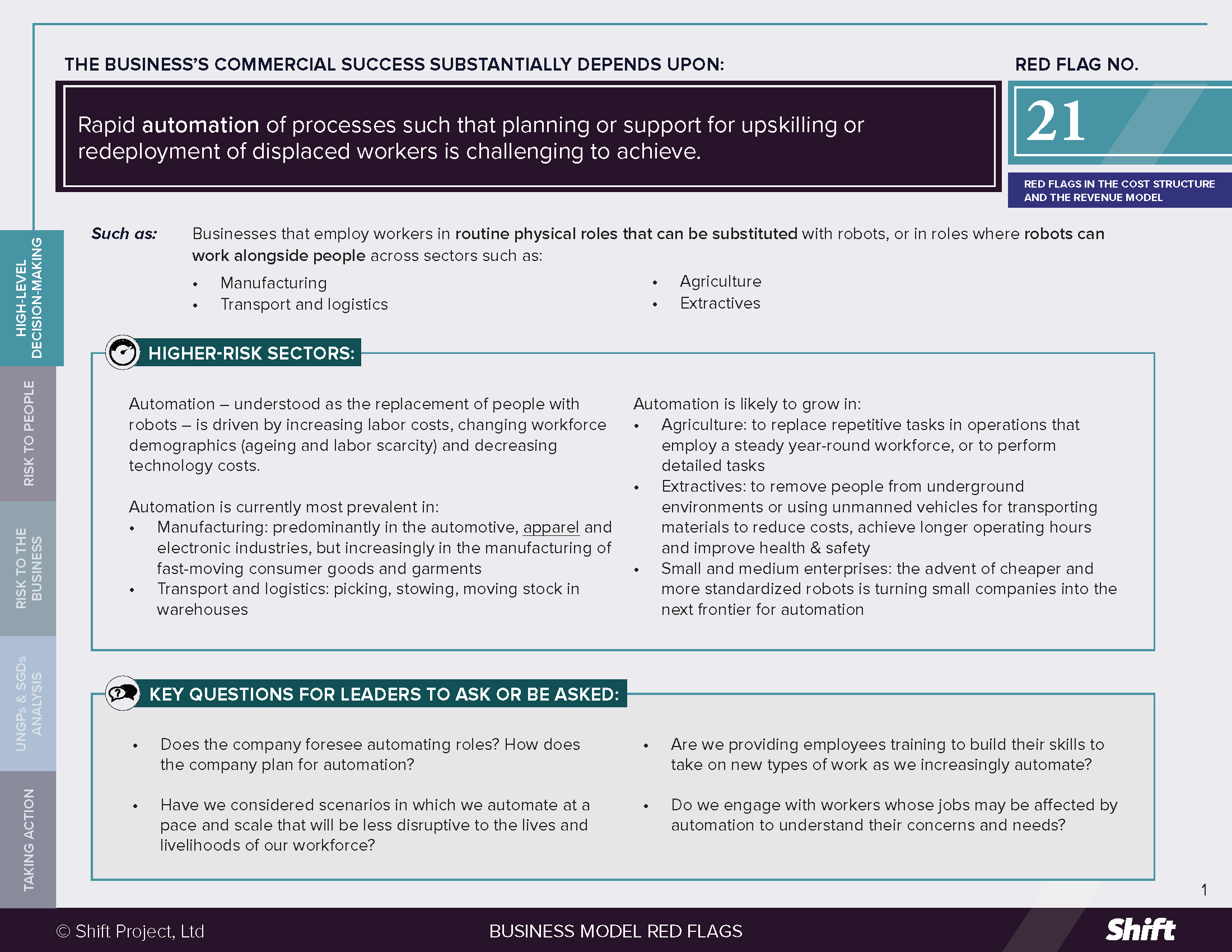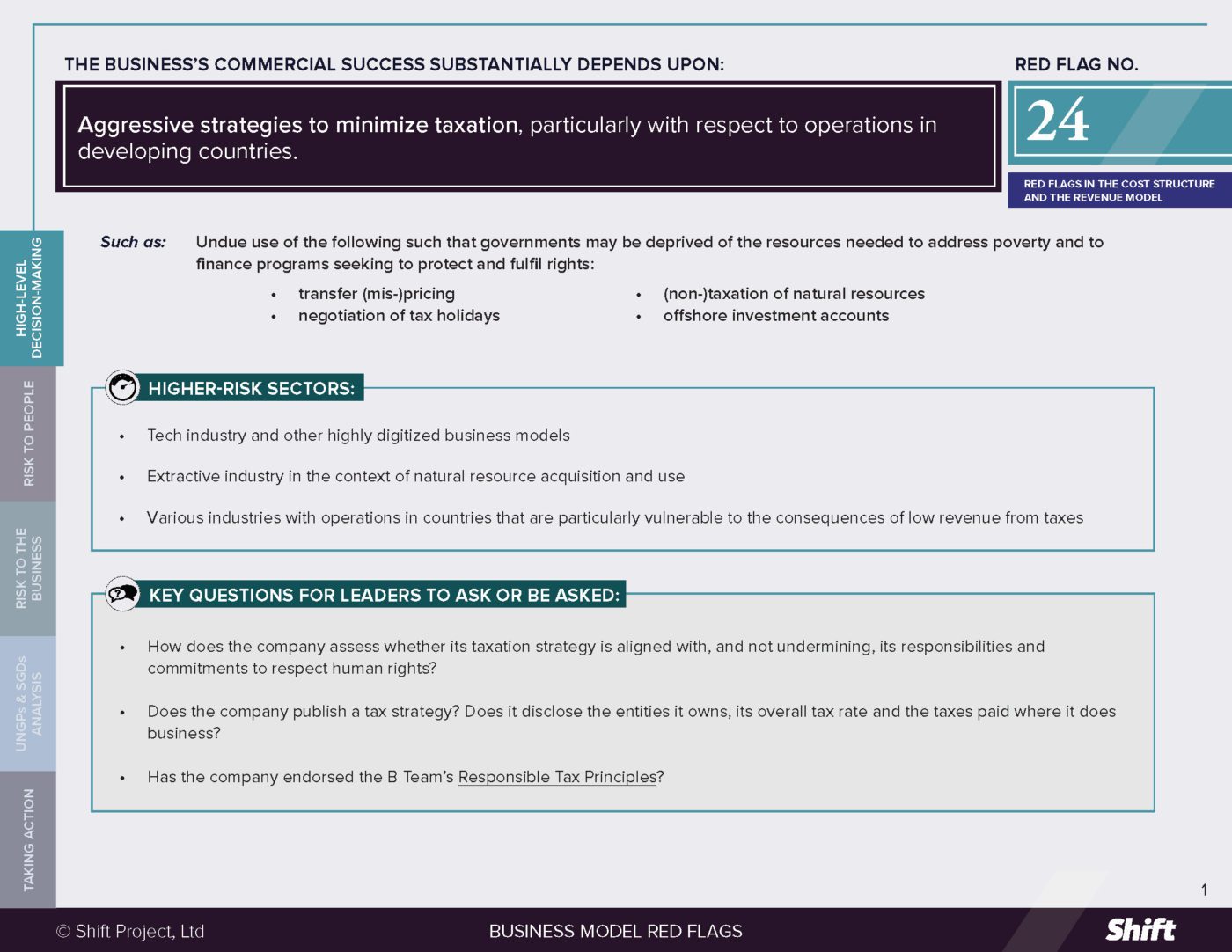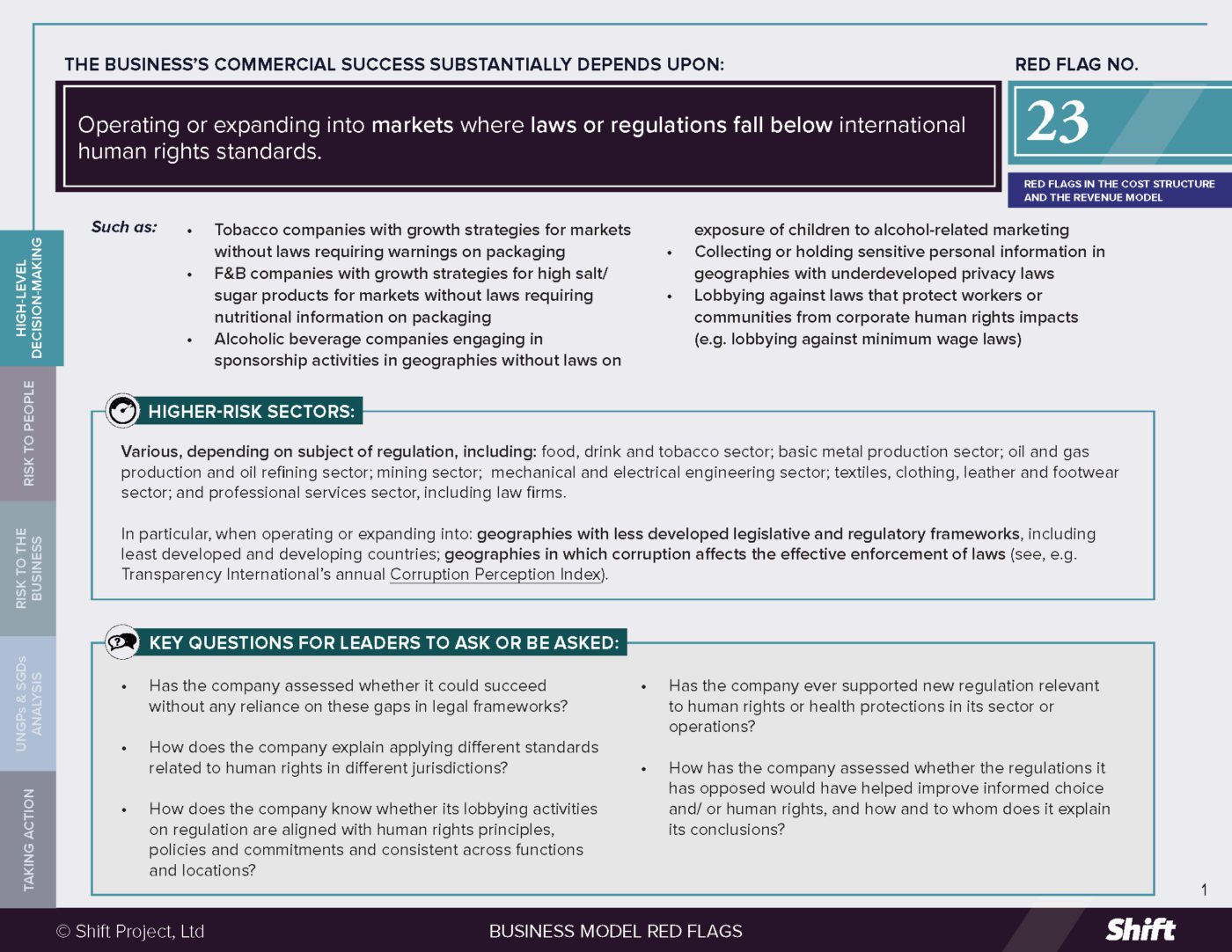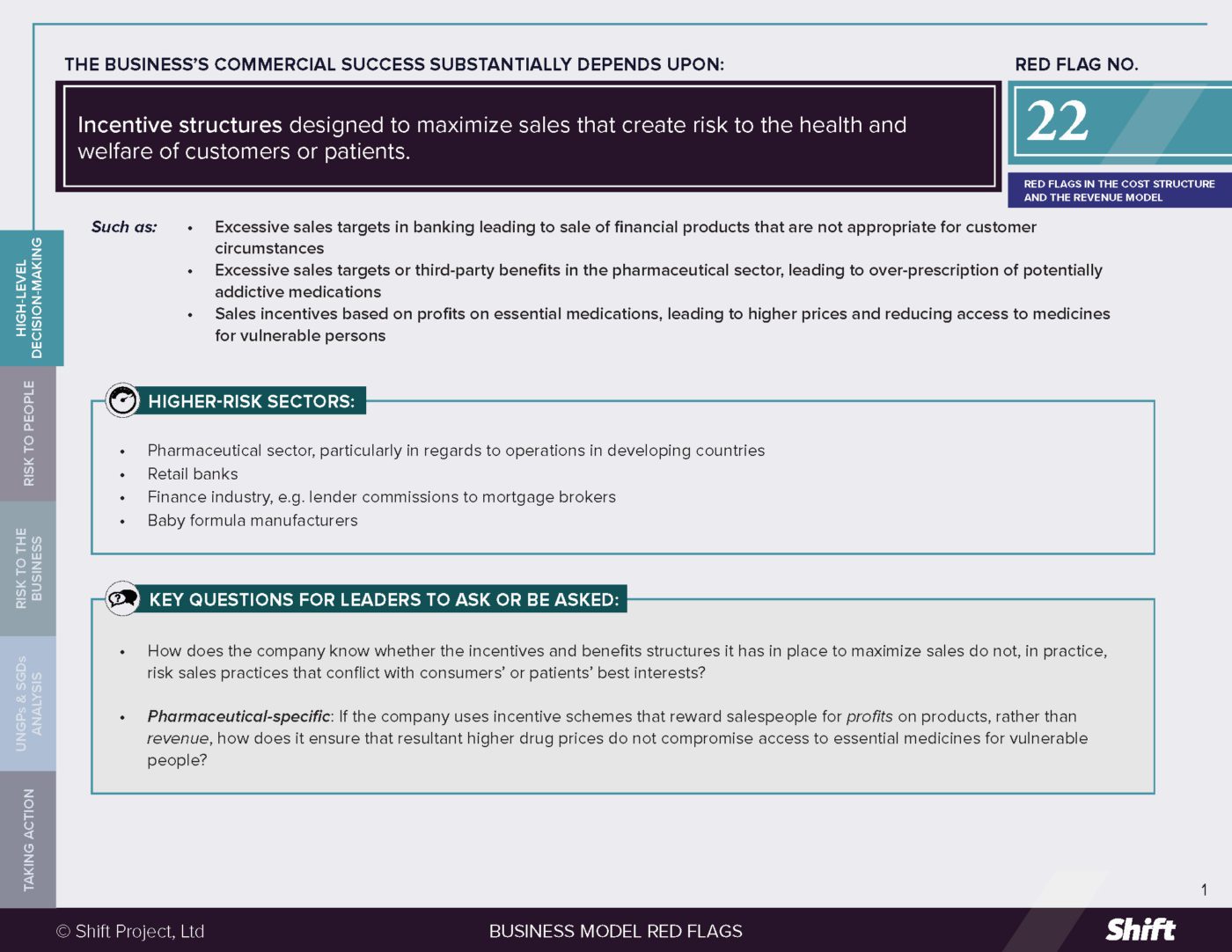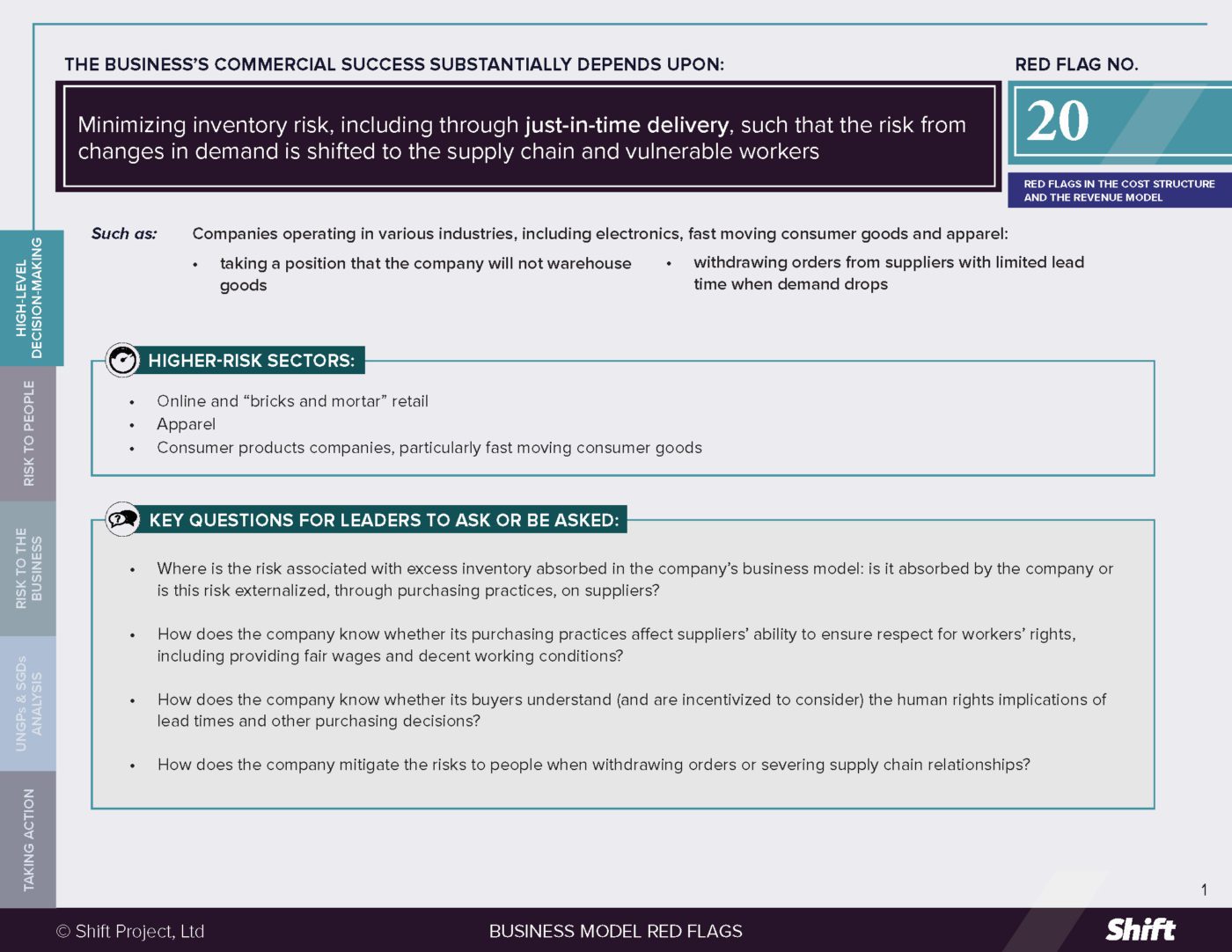RED FLAG # 21
Rapid automation of processes such that planning or support for upskilling or redeployment of displaced workers is challenging to achieve.
For Example
Businesses that employ workers in routine physical roles that can be substituted with robots, or in roles where robots can work alongside people across sectors such as:
- Manufacturing
- Transport and logistics
- Agriculture
- Extractives
Higher-Risk Sectors
Automation – understood as the replacement of people with robots – is driven by increasing labor costs, changing workforce demographics (ageing and labor scarcity) and decreasing technology costs.
Automation is currently most prevalent in:
- Manufacturing: predominantly in the automotive, apparel and electronic industries, but increasingly in the manufacturing of fast-moving consumer goods and garments
- Transport and logistics: picking, stowing, moving stock in warehouses
Automation is likely to grow in:
- Agriculture: to replace repetitive tasks in operations that employ a steady year-round workforce, or to perform detailed tasks
- Extractives: to remove people from underground environments or using unmanned vehicles for transporting materials to reduce costs, achieve longer operating hours and improve health & safety
- Small and medium enterprises: the advent of cheaper and more standardized robots is turning small companies into the next frontier for automation
Questions for Leaders
- Does the company foresee automating roles? How does the company plan for automation?
- Have we considered scenarios in which we automate at a pace and scale that will be less disruptive to the lives and livelihoods of our workforce?
- Are we providing employees training to build their skills to take on new types of work as we increasingly automate?
- Do we engage with workers whose jobs may be affected by automation to understand their concerns and needs?
How to use this resource. ( Click on the “+” sign to expand each section. You can use the side menu to return to the full list of red flags, download this Red Flag as a PDF or share this resource. )
Understanding Risks and Opportunities
Risks to People
The replacement of people with robots is estimated to displace 400 million workers and automate 15% of worked hours across all sectors between 2016 and 2030. While very few jobs are fully replaceable with robots, research shows that many jobs have a significant percentage of automatable activities. Automation’s greatest impact is forecast to be on jobs that consist of routine activities in predictable environments.
Automation of processes through robots can have a number of positive impacts.
In the short term, it can:
- Remove unsafe jobs: in mining, robots can help remove people from dangerous underground jobs, for instance, in Resolute’s Syama mine in Mali.
- Help people with restricted physical ability work.
- Make jobs more accessible for local workers: in mining, robots can provide a simpler visual interface which makes it easier for companies to train local workers, rather than rely on highly- skilled workers from outside the area.
- Increase the number of jobs: in fulfilment centers, robots can increase throughput thus enabling the center to hire more workers to deliver more orders.
- Help manage labor shortages: for example, labor shortages exacerbated by Covid-19 are incentivizing investment in agricultural robots.
In the long term, the history of labor market shifts shows that the overall effects of roboticization can be positive, as the new jobs created outpace the jobs lost and create greater economic prosperity. McKinsey estimates that automation could create between 555 and 980 million jobs by 2030, primarily by virtue of raising incomes through higher productivity, higher wages and lower consumer costs.
At the same time, McKinsey estimates that by 2030, 400 million workers will be displaced by automation and 75 million will need to change occupational category. This shift will put enormous pressure on workers around the world.
Automation will more negatively affect people who are already vulnerable: low paid and precarious workers and minorities that are over-represented in automatable jobs or under-represented in sectors that are likely to experience job growth. For example:
- In the US, African American and Latino workers are projected to be disproportionately affected by automation because they are over-represented in sectors such as transportation, food service and office clerks.
- In Bangladesh, automation in the ready-made garment (RMG) industry is forecast to disproportionately affect women, who comprise 80% of the workforce in the sector.
The negative impacts of automation on people are a result of the way in which companies introduce and use robots. The common denominator in cases of roboticization going wrong (where workers are dehumanized and seen as another input or cost in the production process) is lack of empathy: the ability to put oneself in someone else’s shoes.
When companies introduce automation without empathy with workers, the risks to people can be:
- Loss of Livelihood: Workers who lose their job because they are unable to relocate, retrain or redeploy. IMF research shows women and young workers aged 16-19 will be more negatively affected.
- Lower Wages: Research shows that displaced workers in the US earn 30% less in their next job, and that technology which replaces workers without increasing productivity tends to depress wages of low-skilled workers.
- Deterioration of Working Conditions: Workers in warehouses where robot use has increased, have complained of a faster pace of work and limited time to think. This can lead to an increase in accidents and have negative mental health impacts on workers caused by the pressure to work faster.
- Workplace Accidents: An investigation of health & safety records of warehouses that introduced robots showed a significant increase in workplace accidents.
- Mental Health Problems: Research of economic contractors shows that adverse economic transitions (job loss, transition to inadequate employment or reliance on social safety net) increases the prevalence of depression, suicide and substance abuse.
Risks to the Business
- Operational Disruption and Reputation Risk due to Worker Concerns and Insecurity: Where companies make decisions to automate – and this is done in ways that leave workers uncertain or insecure about their livelihoods – those companies can face public protests, union action, strikes and calls for boycotts. Examples of this include: Australian retailer Coles announcing the automation of warehouses (2020); Automation in Las Vegas casinos (2018) and automation at a Vancouver port (2019).
- Potential Loss of Social License and “Local Content” Incentives: In cases where governments have offered incentives for businesses, in particular, in the extractive industry, to set up operations and employ local people, it may be that large-scale layoffs due to rapid automation will undermine the support of the local government and the population. This possibility is already being raised and explored by civil society and research organizations.
What the UN guiding principles say
*For an explanation of how companies can be involved in human rights impacts, and their related responsibilities, see here.
A company may contribute to negative human rights impacts when it lays off workers as a result of rapid automation without first trying to offer re skilling or upskilling opportunities.
For example, in contexts where there is a weak social safety net or where workers lack alternative employment options or sources of income, rapid automation can result in job losses that leave workers without ways to secure an adequate standard of living. Compounded by the socio-economic context, this can negatively affect workers’ right to health, adequate housing and nutrition.
Buyers and investors may also contribute to negative human rights impacts if they require, respectively, their suppliers or investee companies to automate with no time to support workers in contexts where there are weak social safety nets.
Possible contributions to the SDGs
Technological progress is crucial to the fulfillment of the SDGs. However, to be true to the purpose of the SDGs, the use of technology needs to be underpinned by an understanding of how the loss of jobs due to automation can affect people’s basic dignity and rights.
The introduction of robots with empathy and with support for workers to re-train or upskill can help companies fulfill the following SDGs:
SDG 9: Build resilient infrastructure, promote inclusive and sustainable industrialization and foster innovation, in particular Target 9.2: Promote inclusive and sustainable industrialization.
SDG 8: Promote sustained, inclusive and sustainable economic growth, full and productive employment and decent work for all, in particular Target 8.5: Achieve full and productive employment and decent work for all women and men, including for young people and persons with disabilities.
Taking Action
Due Diligence Lines of Inquiry
While the scale of automation’s impacts on people is undeniable, the nature and gravity of those impacts will depend on the way in which companies apply technology. This includes the due diligence companies carry out to identify and address negative impacts on people. Important questions to consider are:
- Does the company have a culture of empathy that looks not just at the benefits but also the human impacts of automation?
- Do we seek to understand what workers expect from their jobs in terms of progression and development?
- Do we ask how workers feel about the technology that surrounds them at work?
- Do workers have alternative employment options? (Are we the only significant employer in the local area?)
- How robust is the social safety net for workers who are displaced from their jobs?
- Does the business have in place processes to minimize the harm to workers of introducing and using robots?
- Do we have a process to assess impacts on people of new technology or automation in our operations?
- Do we look for unintended negative consequences from technology meant to make work “faster and easier”?
- Do we provide workers with opportunities for continuous learning? Do we recognize and reward that learning?
- Are our governance and internal processes and controls able to manage the additional complexity that comes with automation and technology?
- How do we engage with other stakeholders – including governments and trade unions – to identify ways to prepare workers for a changing landscape of work?
Mitigation Examples
*Mitigation examples are current or historical examples for reference, but do not offer insight into their relative maturity or effectiveness.
Mitigation examples fall into four categories:
- Engaging with Workers: Giving workers early notice that their jobs will be affected and engaging with them to understand their needs and expectations. Examples are:
- Research and forecasting: The European Centre for the Development of Vocational Training provides skills forecasts showing changes in the labor force and types of job openings, which enable workers, employers and governments to prepare in advance.
- Long-term talent pipelines: Caterpillar instituted a talent pipeline management system which enables the company to assess the volume of candidates for six core positions with a 10 year horizon, facilitating the creation of development plans to help workers progress their careers.
- A UK retailer engages with the trade union to set targets for pickers in their highly automated grocery home delivery fulfilment center.
- Supporting Redeployment or Relocation of Existing Workers: Companies can redeploy workers through upskilling or retraining. 62% of executives recently surveyed believed they would need to upskill more than a quarter of their workforce before 2023. Examples are:
- Large companies such as Orange, Verizon and Amazon have announced programs to retrain workers to help them move from positions vulnerable to automation to other jobs.
- Pilot projects in Bangladesh to increase workers’ digital literacy and use of computer-based design to adapt to the increased use of automation in garment factories, at the same time addressing gender imbalances by focusing the training on women.
- Support for workers to relocate to other places where they can access jobs: research in the US shows that the percentage of workers that relocate to access jobs has decreased since 1985; however, more than two-fifths of workers surveyed said they would be willing to relocate for work. Helping workers and their families consider and navigate the relocation process is therefore an alternative to bridging the skills gap.
- Supporting Future Workers to Access the Labor Market: OECD have seen a continued decrease in public spending on labor force training as a percentage of GDP since 1992. Examples of companies helping future workers develop skills abound, including:
- Collaborating to help unemployed youth enter the labor market: in the UK, Movement to Work works with employers to help them implement programs to tackle youth unemployment.
- Implementing employer-led skills development programs with credentials and certifications that workers can take with them as they move jobs.
- Supporting and providing vocational training. For example, JPMorgan Chase funds vocational training in the US through a variety of programs and partnership.
- Using Leverage to Advocate for Public Policies: e.g. wage insurance, universal basic income, smart taxation, closing the gender gap in STEM degrees (only 27% are women).
- Businesses can use their leverage to signal to governments changes needed in education curricula: for example, the Confederation of British Industry has commissioned research to better understand the curriculum changes needed to prepare young people to access the labor market.
- The Social and Economic Council of the Netherlands is a multi-stakeholder body composed of trade unions and employers’ organizations which makes recommendations to the government on how to mitigate the negative impacts of robotization in the labor market. This type of dialogue can help governments drive education and social policy to better prepare future workers and to prevent the dislocation associated with an increase in automation.
- France, Italy and Singapore have created personal training accounts, which allow workers to accrue credit which they can use towards training and upskilling and is transferable between employers. This provides workers with training opportunities that are not tied to their current employer.
- Countries are also creating “skills ecosystems” that enable workers to chart their career path and access lifelong learning, such as Singapore’s Skills Future Movement.
Alternative Models
Alternative models are examples of companies that retain workers instead of replacing them with robots. This does not mean the companies are not automating. It means they are integrating robots with their existing workforce in ways that benefit both workers and the business.
- One emerging trend is to have robots and workers collaborating side-by-side. Research in the automotive sector shows that assembly lines where workers and robots (“co-bots”) worked together were more efficient than lines where workers or robots worked alone.
- Another trend is using automation as an opportunity to provide workers with new skills, particularly to workers who are generally disempowered such as women or ethnic minorities.
Other tools and resources
General:
- OECD (2019) OECD Employment Outlook 2019: The Future of Work.
- International Labour Office (2019) Work for a brighter future: Global Commission on the Future of Work.
Sector specific Examples:
- ILO, David Kucera and Fernanda Bárcia de Mattos (2020) Automation, employment and reshoring: Case studies of the apparel and electronics industries: a study of automation in the apparel and electronics industries.

 Business Model Red Flags
Business Model Red Flags  Tool for Indicator Design
Tool for Indicator Design 